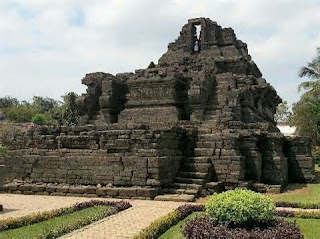Jumat, 19 Juli 2013
Jago temple
Candi Jago Jago is located in the hamlet, village Overlapping, Overlapping District, Malang regency, precisely 22 km to the east of the city of Malang. Because of its location in the village of Overlapping, this temple is often also called the Temple Tumpang. Locals call it the Dome. According to the book Negarakertagama and Pararaton, the actual name of this temple is Jajaghu. In stanza 41 gatra 4th Negarakertagama explained that the King Wisnuwardhana Singasari ruled Shiva embraced Buddhism, which is a religious sect which is a blend of Hinduism and Buddhism. The flow developed during the reign of the Kingdom Singasari, a kingdom which is located about 20 km from Candi Jago. Jajaghu, which means 'greatness', a term used to refer to the sacred place. Still according to the book Negarakertagama and Pararaton, Candi Jago ongoing development since in 1268 AD until 1280 AD, as a tribute to the King Singasari 4th, the Sri Jaya Wisnuwardhana. Although it was built during the reign of the Kingdom Singasari, mentioned in both books that Candi Jago during the year 1359 AD is one of the places frequented by King Hayam Wuruk of Majapahit Kingdom. Candi Jago linkages with the Kingdom Singasari seen also from sculpture lotus (lotus), which extends to the top of the cob, whose statues adorn the mat. Such lotus motif was very popular during the Empire Singasari. What to watch in the history of the temple is the habit of ancient kings to restore the temples established by previous kings. Candi Jago allegedly also has undergone restoration in the year 1343 AD on the orders of King Adityawarman of Malays who still have blood ties to the King Hayam Wuruk. Currently Candi Jago in ruins that have not been restored. Overall rectangular temple building with an area of 23 x 14 m. The roof has gone, so that the original building height can not be known with certainty. It is estimated that up to 15 m high. Temple facing west, standing on approximately 1 m tall platform and the foot of the temple consists of 3 storey terrace. Getting to the top, decreasing the foot of the temple terrace so that the first and second floor there is a hall that can be passed to surround the temple. Garba Ghra (main hall) is shifted slightly to the rear. Composite building form, berselasar and shifted to the rear is a common form encountered in building the megalithic era, namely the so-called building punden. Form that is commonly used in building a place of worship ancestral spirits. Given its shape, it is estimated that the development goals for the Candi Jago is also a place of worship ancestral spirits. But still required further research and studies to prove its truth. To ascend to the upper floor, there are two narrow staircase on the left and right of the front (west). Floor most important role is the holiest and most top, the building that is located slightly shifted to the rear. Jago temple was filled with relief panels neatly carved from the feet up to the top wall of the room. There was hardly an empty field, because all filled with a variety of ornaments in the fabric of the stories contain elements of the release of the departure. This reinforces the notion that development is closely related to Candi Jago Sri Jaya Wisnuwardhana death. In accordance with the religion professed by King Wisnuwardhana, namely Shiva Buddha, the temple reliefs at the containing Jago Hindu and Buddhist teachings. Buddhism is reflected in the story Tantri reliefs Kamandaka and Kunjarakarna story carved on the bottom terrace. On the second terrace wall sculpted Kunjarakarna stories and excerpts follow the story of Mahabharata which contains the teachings of Hinduism, namely Parthayajna and Arjuna Wiwaha. The third terrace is filled with continued relief Arjunawiwaha story. The walls of the temple are also filled with bas-reliefs of Hindu stories, the war Krishna with Kalayawana. In the middle of the front yard, about 6 m from the foot of the temple, there is a large stone carved statue resembles a giant saucer shape, with a diameter of about 1 m rock. On top are carved lotus flower that protrude from the cob.
Langganan:
Posting Komentar (Atom)



Tidak ada komentar:
Posting Komentar